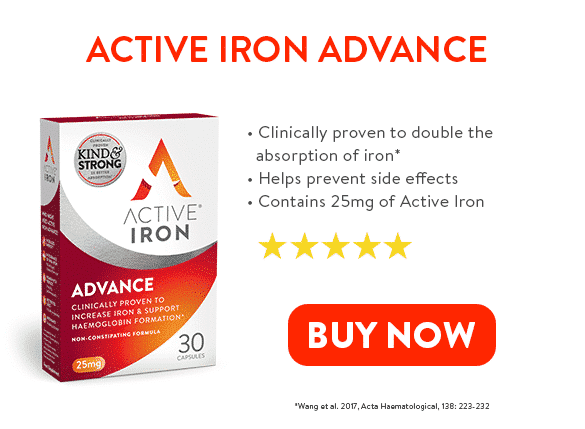When it comes to essential minerals, iron and calcium are some of the most important. Iron’s main role is to help transport oxygen around the body. It’s also important for brain function, and a healthy immune system. Calcium is vital for healthy bones and teeth. And it also helps normal blood clotting. For optimum health and wellbeing, calcium and iron are crucial to a balanced diet.
We are often asked the question whether you can take iron and calcium supplements together. Some people are concerned that calcium interferes with iron absorption.
This article takes you through everything you need to know about the relationship between calcium and iron. Topics covered include the following:
- The effects of calcium on iron absorption.
- Whether there are any risks to taking iron and calcium together.
- Foods rich in iron and calcium.
By the time you have finished reading, you will have a better understanding of the relationship between iron and calcium.
Calcium and Iron Absorption
There are two primary sources of dietary iron. Haem iron comes mainly from animal sources – think red meat, chicken and shellfish. In contrast, non-haem iron is plant-based. Good sources include fortified cereals, beans and legumes, dried fruits, leafy greens and vegetables.
Unlike non-haem iron, the body finds it easier to absorb haem iron. Other factors also affect iron absorption. The tannins in tea and coffee, for example, are known to inhibit iron absorption, while vitamin C has a positive effect. So, swapping your cup of tea for a glass of orange juice at mealtimes is one way to help your body to absorb more iron.
Google “calcium and iron absorption” and you will find a mixed bag of results. Some experts suggest that calcium inhibits iron absorption, while other sources say that it doesn’t.
The truth is that in some highly controlled, short-term studies, calcium has interfered with iron absorption. It can bind to iron, making it harder for the body to absorb. However, when you look at the data collected over much longer periods of time, it’s a different story. The
Active Iron uses a ground-breaking whey protein formula to allow iron to be carried to the site of natural absorption in the gut, the DMT-1, unlike standard iron sulfate which breaks down in the stomach. This is why Active Iron has clinically proven 2X absorption than iron sulphate and fewer side effects such as nausea, reflux and constipation.
Can You Take Calcium and Iron Together?
As part of a balanced diet, it’s safe to eat calcium and iron together. However, if you want to maximise iron absorption, drink your glass of milk a couple of hours after eating rather than at mealtimes. Non-dairy milk alternatives are fine to have at any time.
In an ideal world, we would all get enough calcium and iron from the foods we eat. However, some people find it hard to get enough from dietary sources alone and take calcium and iron supplements.
And when it comes to taking calcium and iron supplements, again it’s best not to take them at the same time. As we discussed earlier, calcium can have a short-term effect on iron absorption. To avoid this, take your iron supplement separate from your calcium supplement. It is recommended to allow 3-4 hours between taking your iron and calcium supplements. Generally, the best time to take your iron supplement is between meals or 30-60 minutes before eating, including tea, coffee, and dairy products.
Does Calcium Inhibit Iron Absorption?
There is some evidence that calcium blocks iron absorption in the short term. However, studies have shown that over a much longer timeframe, there is no substantial effect. (references)
To maximise the benefits, avoid taking iron and calcium supplements together. Spacing them apart at different times of the day ensures you get the best out of both supplements.
Foods Rich in Iron and Calcium
So, what foodstuffs are rich in calcium and iron? Here’s a list of the best foods to eat if you want to increase calcium and iron in your diet.
- Meat, fish, and eggs: these food groups, especially red meat, canned tuna, and sardines, are high in both iron and calcium.
- Beans and lentils: all types of legumes are good sources of both dietary iron and calcium.
- Vegetables: leafy greens such as kale and Collard greens are good choices, and broccoli also ticks both boxes.
- Nuts and seeds: adding pumpkin seeds, almonds, and walnuts to your diet will see you increase your intake of both calcium and iron.
- Fruits: Dried fruits like raisins, apricots, and prunes are rich in iron. And oranges, blackcurrants, and blackberries for calcium.
Conclusion: Iron and Calcium
Iron and calcium are essential minerals, vital to our health and wellbeing. With today’s busy lifestyles, getting enough from the food we eat alone can be a challenge.
For many people, iron and calcium supplements offer the perfect solution. And the good news is, it is possible to take calcium and iron together. Just make sure you take them at different times of the day to get the best results.
Active Iron’s ground-breaking formula is kind to the stomach and easy to absorb. Clinical research shows that Active Iron’s unique formulation provides a higher rate of absorption of iron than other oral irons on the market. Formulated by scientists and easy to swallow, Active Iron is so gentle, that you can even take it on an empty stomach.
Our expert team is here to help. If you have any concerns about taking Active Iron with your calcium supplement, then get in touch.

Dr Kiran Rahim
MBBS BSc MRCGP
Kiran is a NHS Doctor, specialising in baby, child and adolescent health. She has worked across many London Hospitals and uses her own experience as a mother and south Asian woman to talk about key issues relating to women and child health.
Read more about our expert here.


